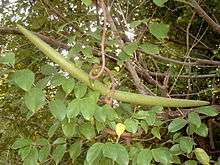Strophanthus sarmentosus
Strophanthus sarmentosus grows as either a deciduous shrub or as a liana up to 40 metres (130 ft) long, with a stem diameter up to 15 centimetres (6 in). Its fragrant flowers feature a white to purple corolla, red or purple-streaked on the inside. Vernacular names for the plant include spider tresses and poison arrow vine. Its habitat is forested areas from sea level to 1,400 metres (4,600 ft) altitude. The numerous local medicinal uses of S. sarmentosus include treatment of joint pain, head lice, eye conditions and venereal disease. The plant has also been used as arrow poison.[2] Botanist John Baldwin discovered that Strophanthus sarmentosus was a natural source of the steroid hormone cortisone.[3] The sarmentosus plant was used in the early manufacture of cortisone-based drugs.[3] Strophanthus sarmentosus is native from west and central tropical Africa to Uganda and Angola.[1][2]
| Strophanthus sarmentosus | |
|---|---|
 | |
| Scientific classification | |
| Kingdom: | Plantae |
| Clade: | Tracheophytes |
| Clade: | Angiosperms |
| Clade: | Eudicots |
| Clade: | Asterids |
| Order: | Gentianales |
| Family: | Apocynaceae |
| Genus: | Strophanthus |
| Species: | S. sarmentosus |
| Binomial name | |
| Strophanthus sarmentosus | |
| Synonyms[1] | |
| |
References
- "Strophanthus sarmentosus". World Checklist of Selected Plant Families (WCSP). Royal Botanic Gardens, Kew. Retrieved 2 August 2017.
- Medicinal Plants. PROTA. 2008. pp. 557–559. ISBN 978-9-05782-204-9.
- "John T. Baldwin Jr., Botanist, 63, Dead". The New York Times. 5 September 1974. Retrieved 8 February 2020.
| Wikimedia Commons has media related to Strophanthus sarmentosus. |
| Wikispecies has information related to Strophanthus sarmentosus |